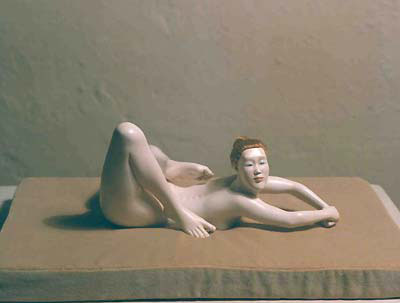 Japanese girl II painted Bronze, length: 13-1/2 in / 35 cm Reg Butler Gimpel Fils is pleased to present a retrospective exhibition of sculptural work by Reg Butler. Reg Butler (1913-1981) was born in Hertfordshire, and started his career as an architect. He became interested in sculpture when looking at how architectural space and sculpture worked together. After lecturing at the Architectural Association School he worked as an apprentice to Henry Moore, who influenced his early female forms. But his interest in welding and metalwork, alongside his thoughts on architectural scale, led him to develop wiry and linear figures. Butler's sinewy, skeletal work of the late 1940s depict insect-like figures, and have been described as an interpretation of the body conveying loss of self. Butler was interested in the denial of mass, he thought of these works as drawings in space- defining it - but not filling it. Cutting and forging metal, Butler created tense, strong and upright, constructions, in direct contrast to Moore's solid reclining figures, popular at the time. Works such as "Woman", 1949, shown at the Venice Biennale in 1952, display a barren view of the body as an empty-headed machine, giving recognisable human characteristics to forms usually associated with insects and plants. In this work it is clear that Butler was exploring the relationship between humanity and machine that preoccupied a number of artists in the aftermath of the Second World War. In the years between 1950-1954, Butler became the most talked-about sculptor of his generation with his participation in "The Festival of Britain" in 1951, The Venice Biennale in 1952, and with his winning entry in the competition for a "Monument to the Unknown Political Prisoner" in 1953. It was during these years that Butler matured as an artist and established certain features and characteristics that would remain evident throughout his career; the cage, the watchers, and the female form. The competition for a "Monument to the Unknown Political Prisoner" of 1953 was an international competition held at the Tate Gallery, and provoked a public debate of unprecedented vigour. The aim of the competition was to create a memorial "to pay tribute to those individuals who, in many countries and diverse political situations, had dared to offer their liberty or their lives for the cause of human freedom". Butler's design won first prize, and was described by Herbert Read "an emblem purged of pity and terror, a luminous and enduring act of meditation on the liberating significance of sacrifice". However, the competition faced multiple problems and the scheme was finally abandoned in 1960. Butler continued to work and exhibit throughout the 1950s and 60s, and his linear iron constructions developed into bronze figurative forms. These solid but incomplete female bodies look vulnerable and uneasy; balanced upon delicate stands or trapped within a linear network, they are reminders of human fragility and external systems of control. Butler's late works of the 1970s further explore the manipulation of the female figure. These figures are fluid, realistic forms; sometimes contorted into impossible and grotesque positions, the bronzes are painted in a glossy pale flesh tone and adorned with real human hair. All Butler's figurative work of female bodies display manipulated, tortured or futile sensibilities, while rare representations of men are shown operating machinery or in another position of control. His work caused controversy with its Francis Bacon-inspired cruelty to the human, particularly the female, body, its dismemberment denying it intellect and gender. These late bronzes testify to Butler's hitherto unrecognised importance and relevancy to contemporary sculpture and gender politics. Reg Butler had his first solo exhibition in 1949 at the Hanover Gallery, London. He exhibited widely throughout his career, and in 1986 Gimpel Fils held an exhibition of Butlers bronze's, Musee Imaginaire: Bronzes Middle & Late Period. His work can be found in numerous international public collections including Tate Gallery, British Museum, Hakone Open Air Museum, Japan, Peggy Guggenheim Collection, Museum of Modern Art, New York, Hirshhorn Museum Sculpture Garden, and the Smithsonian Institution. 11 September - 11 October 2003 Hours: Mon - Fri 10am - 5.30pm, Sat 11am - 4pm Gimpel Fils 30 Davies Street GB-London, W1K 4NB Telefon +44 20 7493 2488 Fax +44 20 7629 5732 E-Mail info@gimpelfils.com www.gimpelfils.com |